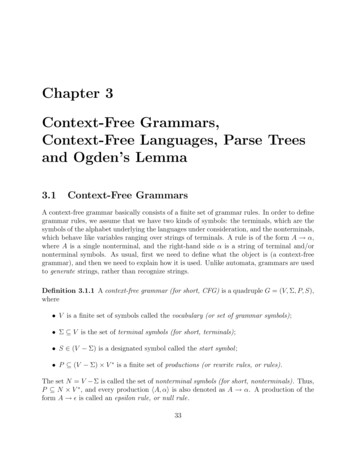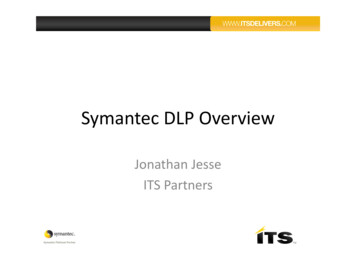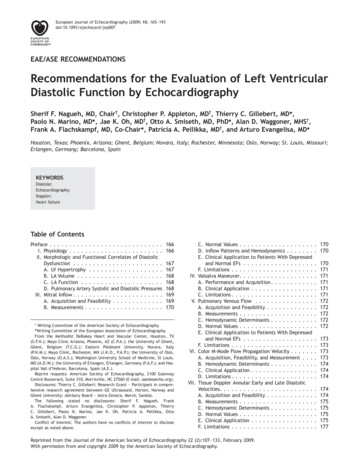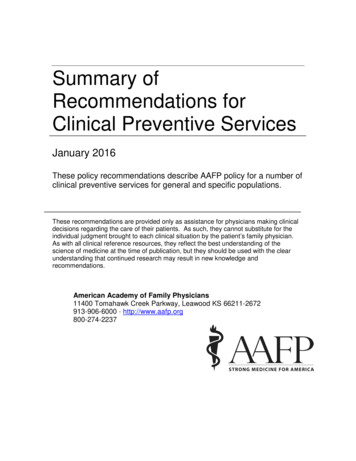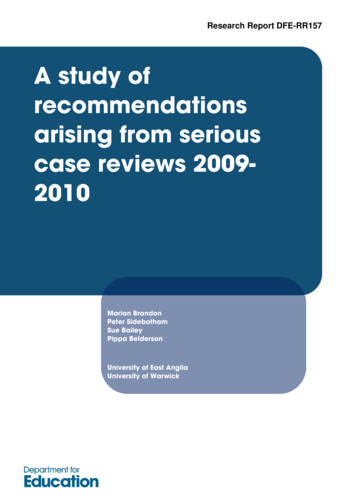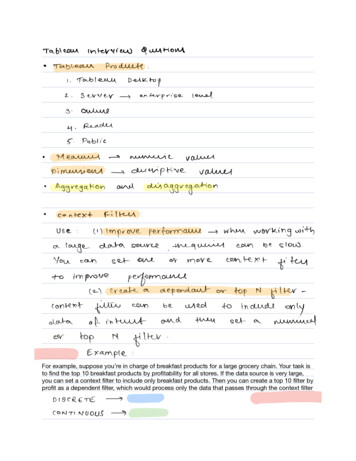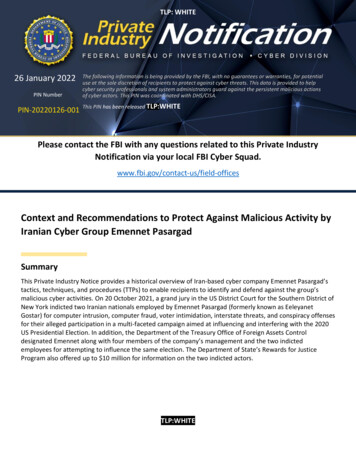
Transcription
TLP: WHITE26 January 2022PIN NumberPIN-20220126-001The following information is being provided by the FBI, with no guarantees or warranties, for potentialuse at the sole discretion of recipients to protect against cyber threats. This data is provided to helpcyber security professionals and system administrators guard against the persistent malicious actionsof cyber actors. This PIN was coordinated with DHS/CISA.This PIN has been released TLP:WHITEPlease contact the FBI with any questions related to this Private IndustryNotification via your local FBI Cyber Squad.www.fbi.gov/contact-us/field-officesContext and Recommendations to Protect Against Malicious Activity byIranian Cyber Group Emennet PasargadSummaryThis Private Industry Notice provides a historical overview of Iran-based cyber company Emennet Pasargad’stactics, techniques, and procedures (TTPs) to enable recipients to identify and defend against the group’smalicious cyber activities. On 20 October 2021, a grand jury in the US District Court for the Southern District ofNew York indicted two Iranian nationals employed by Emennet Pasargad (formerly known as EeleyanetGostar) for computer intrusion, computer fraud, voter intimidation, interstate threats, and conspiracy offensesfor their alleged participation in a multi-faceted campaign aimed at influencing and interfering with the 2020US Presidential Election. In addition, the Department of the Treasury Office of Foreign Assets Controldesignated Emennet along with four members of the company’s management and the two indictedemployees for attempting to influence the same election. The Department of State’s Rewards for JusticeProgram also offered up to 10 million for information on the two indicted actors.TLP:WHITE
TLP:WHITEThreatStarting in August 2020, Emennet Pasargad actors conducted a multi-faceted campaign to interfere in the2020 US presidential election. As part of this campaign, the actors obtained confidential U.S. voter informationfrom at least one state election website; sent threatening email messages to intimidate voters; created anddisseminated a video containing disinformation pertaining to purported but non-existent votingvulnerabilities; attempted to access, without authorization, several states’ voting-related websites; andsuccessfully gained unauthorized access to a U.S. media company’s computer network. During the 2020election interference campaign, the actors claimed affiliation with the Proud Boys in the voter intimidationand disinformation aspects of the campaign.In addition to the 2020 U.S. election-focused operation in which the actors masqueraded as members of theProud Boys, Emennet previously conducted cyber-enabled information operations, including operations thatused a false-flag persona. According to FBI information, in late 2018, the group masqueraded as the "YemenCyber Army" and crafted messaging critical of Saudi Arabia. Emennet also demonstrated interest in leveragingbulk SMS services, likely as a means to mass-disseminate propaganda or other messaging.FBI information indicates Emennet poses a broader cybersecurity threat outside of information operations.Since 2018, Emennet has conducted traditional cyber exploitation activity targeting several sectors, includingnews, shipping, travel (hotels and airlines), oil and petrochemical, financial, and telecommunications, in theUnited States, Europe, and the Middle East.Tactics, Techniques, and ProceduresThe FBI is providing a summary of the group's past TTPs to recipients so they can better understand anddefend against the group’s future malicious activity.Emennet is known to use Virtual Private Network (VPN) services to obfuscate the origin of their activity. Thegroup likely uses VPN services including TorGuard, CyberGhost, NordVPN, and Private Internet Access.Over the past three years, Emennet conducted reconnaissance and chose potential victims by performing websearches for leading businesses in various sectors such as “top American news sites.” Emennet would then usethese results to scan websites for vulnerable software that could be exploited to establish persistent access. Insome instances, the objective may have been to exploit a large number of networks/websites in a particularsector as opposed to a specific organization target. In other situations, Emennet would also attempt to identifyhosting/shared hosting services.After the initial reconnaissance phase, Emennet typically researched how to exploit specific software,including identifying open source available tools. In particular, Emennet demonstrated interest in identifyingwebpages running PHP code and identifying externally accessible mysql databases (in particular,phpMyAdmin). Emennet also demonstrated an interest in exploiting the below software applications: Wordpress (in particular the revslider and layerslider plugins)DrupalApache TomcatCkeditor and Fckeditor (including the exploitation of Roxy Fileman)TLP:WHITE
TLP:WHITEEmennet also expressed interest in numerous specific vulnerabilities, outlined in Appendix A.When conducting research, Emennet attempted to identify default passwords for particular applications atarget may be using, and tried to identify admin and/or login pages associated with those same targetedwebsites. It should be assumed Emennet may attempt common plaintext passwords for any login sites theyidentify.Emennet is known to use the open source penetration testing tools SQLmap and the commercially availabletool Acunetix during operational activity. They also likely use the below tools or resources: DefenseCode Web Security ScannerWappalyzerDnsdumpsterTiny mce scannerNetsparkerWordpress security scanner (wpscan)ShodanFBI information indicates the group has attempted to leverage cyber intrusions conducted by other actors fortheir own benefit. This includes searching for data hacked and leaked by other actors, and attempting toidentify webshells that may have been placed or used by other cyber actors.Recommendations Ensure anti-virus and anti-malware software is enabled and signature definitions are updated regularlyin a timely manner. Well-maintained anti-virus software may prevent use of commonly deployedattacker tools that are delivered via spear-phishing. Adopt threat reputation services at the network device, operating system, application, and emailservice levels. Reputation services can be used to detect or prevent low-reputation email addresses,files, URLs, and IP addresses used in spear-phishing attacks. If your organization’s information was previously compromised, the FBI recommends considering howany data exfiltrated could be leveraged to conduct further malicious activity against your network, andtake appropriate measures to ensure security mechanisms are in place. If your organization is employing certain types of software and appliances referenced in theaforementioned CVEs, the FBI recommends patching for those vulnerabilities. Review the Tactics, Techniques, and Procedures in the referenced table and take steps to ensure youcan identify and defend against malicious activity by this actor. Consider reputable hosting services for websites and content management systems (CMS), if you needassistance in configuring and maintaining your external facing applications.TLP:WHITE
TLP:WHITE Consider employing a Web Application Firewall (WAF) to block inbound malicious traffic. Disable Content Management Systems features if they are not needed, and configure them to:o Disable remote file editingo Restrict file execution to specific directorieso Limit login attempts Review the logs generated by security devices for signs that your organizations external networks arebeing scanned for vulnerabilities.Reporting NoticeThe FBI encourages recipients of this document to report information concerning suspicious or criminalactivity to their local FBI field office. Field office contacts can be identified at www.fbi.gov/contact-us/fieldoffices. When available, each report submitted should include the date, time, location, type of activity,number of people, and type of equipment used for the activity, the name of the submitting company ororganization, and a designated point of contact.The FBI also notes the Department of State’s Rewards for Justice Program is offering up to 10 million forinformation leading to the identification or location of Emennet-associated cyber actors Seyyed MohammadHosein Musa Kazemi and Sajjad Kashian: t-rewards/sajjad-kashian/Administrative NoteThis product is marked TLP:WHITE. Subject to standard copyright rules, the information in this product may beshared without restriction.Your Feedback Regarding this Product is CriticalPlease take a few minutes to send us your feedback. Your feedback submissionmay be anonymous. We read each submission carefully, and your feedback willbe extremely valuable to the FBI. Feedback should be specific to yourexperience with our written products to enable the FBI to make quick andcontinuous improvements to these TLP:WHITEproducts. Feedback may be submittedonline here: https://www.ic3.gov/PIFSurvey
TLP:WHITEAppendix 81000001CVE-2014-0160CVE n running on Windows with enableCmdLineArguments enabled, the CGI Servlet in Apache Tomcat 9.0.0.M1 to 9.0.17,8.5.0 to 8.5.39 and 7.0.0 to 7.0.93 is vulnerable to Remote Code Execution due to a bug in the way the JRE passes commandline arguments to Windows. The CGI Servlet is disabled by default. The CGI option enableCmdLineArguments is disabled bydefault in Tomcat 9.0.x (and will be disabled by default in all versions in response to this vulnerability). For a detailedexplanation of the JRE behavior, see Markus Wulftange's blog dcommand-line-injections-in-windows.html) and this archived MSDN arguments-the-wrong-way/).An issue was discovered in caddy (for TYPO3) before 7.2.10. The vulnerability exists due to insufficient filtration of usersupplied data in the "paymillToken" HTTP POST parameter passed to the l/api/php/payment.php" URL. An attacker could execute arbitrary HTML and script code in a browser in thecontext of the vulnerable website.Drupal before 7.58, 8.x before 8.3.9, 8.4.x before 8.4.6, and 8.5.x before 8.5.1 allows remote attackers to execute arbitrarycode because of an issue affecting multiple subsystems with default or common module configurations.In glibc 2.26 and earlier there is confusion in the usage of getcwd() by realpath() which can be used to write before thedestination buffer leading to a buffer underflow and potential code execution.The (1) TLS and (2) DTLS implementations in OpenSSL 1.0.1 before 1.0.1g do not properly handle Heartbeat Extensionpackets, which allows remote attackers to obtain sensitive information from process memory via crafted packets thattrigger a buffer over-read, as demonstrated by reading private keys, related to d1 both.c and t1 lib.c, aka the Heartbleedbug.SolarWinds Orion Platform before 2018.4 Hotfix 2 allows privlege escalation through the RabbitMQ service.The mailSend function in the isMail transport in PHPMailer before 5.2.18 might allow remote attackers to pass extraparameters to the mail command and consequently execute arbitrary code via a \" (backslash double quote) in a craftedSender property.Static code injection vulnerability in setup.php in phpMyAdmin 2.11.x before 2.11.9.5 and 3.x before 3.1.3.1 allows remoteattackers to inject arbitrary PHP code into a configuration file via the save action.TLP:WHITE
14726CVE-2017-5611DescriptionThe AliasHandler component in PostfixAdmin before 3.0.2 allows remote authenticated domain admins to delete protectedaliases via the delete parameter to delete.php, involving a missing permission check.A remote code execution vulnerability exists in Remote Desktop Services formerly known as Terminal Services when anunauthenticated attacker connects to the target system using RDP and sends specifically crafted requests, aka 'RemoteDesktop Services Remote Code Execution Vulnerability".Windows COM Aggregate Marshaler in Microsoft Windows Server 2008 SP2 and R2 SP1, Windows 7 SP1, Windows 8.1,Windows Server 2012 Gold and R2, Windows RT 8.1, Windows 10 Gold, 1511, 1607, and 1703, and Windows Server 2016allows an elevation privilege vulnerability when an attacker runs a specially crafted application, aka "Windows COMElevation of Privilege Vulnerability". This CVE ID is unique from CVE-2017-0214.An elevation of privilege vulnerability exists in Windows when the Win32k component fails to properly handle objects inmemory, aka "Win32k Elevation of Privilege Vulnerability." This affects Windows 7, Windows Server 2012 R2, Windows RT8.1, Windows Server 2008, Windows Server 2019, Windows Server 2012, Windows 8.1, Windows Server 2016, WindowsServer 2008 R2, Windows 10, Windows 10 Servers. This CVE ID is unique from CVE-2018-8641.Before version 4.8.2, WordPress mishandled % characters and additional placeholder values in wpdb- prepare, and thusdid not properly address the possibility of plugins and themes enabling SQL injection attacks.WordPress through 4.7.4 relies on the Host HTTP header for a password-reset e-mail message, which makes it easier forremote attackers to reset arbitrary passwords by making a crafted wp-login.php?action lostpassword request and thenarranging for this message to bounce or be resent, leading to transmission of the reset key to a mailbox on an attackercontrolled SMTP server. This is related to problematic use of the SERVER NAME variable in wp-includes/pluggable.php inconjunction with the PHP mail function. Exploitation is not achievable in all cases because it requires at least one of thefollowing: (1) the attacker can prevent the victim from receiving any e-mail messages for an extended period of time (suchas 5 days), (2) the victim's e-mail system sends an autoresponse containing the original message, or (3) the victim manuallycomposes a reply containing the original message.Before version 4.8.2, WordPress was vulnerable to a cross-site scripting attack via shortcodes in the TinyMCE visual editor.SQL injection vulnerability in wp-includes/class-wp-query.php in WP Query in WordPress before 4.7.2 allows remoteattackers to execute arbitrary SQL commands by leveraging the presence of an affected plugin or theme that mishandles acrafted post type name.TLP:WHITE
eceipt of a specific packet on the out-of-band management interface fxp0 may cause the system to crash and restart(vmcore). By continuously sending a specifically crafted packet to the fxp0 interface, an attacker can repetitively crash therpd process causing prolonged Denial of Service (DoS). Affected releases are Juniper Networks SRX5000 Series: 12.1.X46versions prior to 12.1X46-D82; 12.3X48 versions prior to 12.3X48-D80; 15.1.X49 versions prior to 15.1.X49-D160.Zimbra Collaboration Suite before 8.6 patch 13, 8.7.x before 8.7.11 patch 10, and 8.8.x before 8.8.10 patch 7 or 8.8.x before8.8.11 patch 3 allows SSRF via the ProxyServelet componet.Source: National Vulnerability Database (nvd.nist.gov)TLP:WHITE
Wordpress (in particular the revslider and layerslider plugins) Drupal . Adopt threat reputation services at the network device, operating system, application, and email service levels. Reputation services can be used to detect or prevent low-reputation email addresses, . Consider employing a Web

